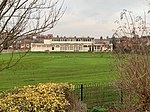Filbert Street
1891 establishments in EnglandDefunct football venues in EnglandDemolished sports venues in the United KingdomEnglish Football League venuesLeicester City F.C. ... and 5 more
Premier League venuesSports venues completed in 1891Sports venues demolished in 2003Sports venues in LeicesterUse British English from February 2023

Filbert Street was a football stadium in Leicester, England, which served as the home of Leicester City F.C. from 1891 until 2002. Although officially titled the City Business Stadium in the early 1990s, it remained known almost exclusively by its address, like many English football stadiums.
Excerpt from the Wikipedia article Filbert Street (License: CC BY-SA 3.0, Authors, Images).Filbert Street
Lineker Road, Leicester Bede Island
Geographical coordinates (GPS) Address Nearby Places Show on map
Geographical coordinates (GPS)
| Latitude | Longitude |
|---|---|
| N 52.623611111111 ° | E -1.1405555555556 ° |
Address
Lineker Road
Lineker Road
LE2 7FZ Leicester, Bede Island
England, United Kingdom
Open on Google Maps







